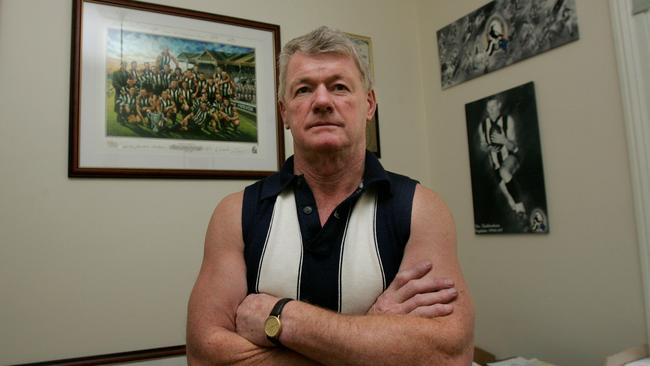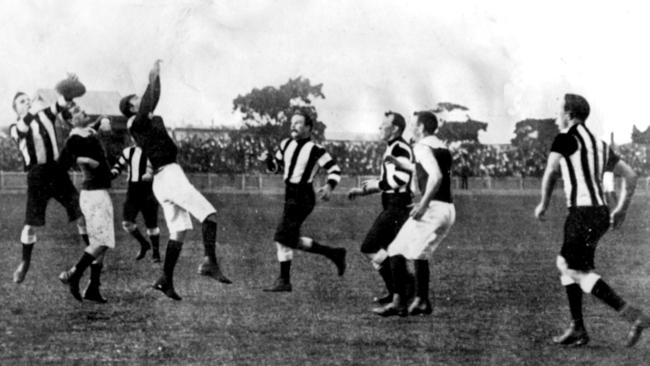AFL Rich 100: How AFL player salaries compare to superstar athletes around the world
Some of the AFL’s biggest names are earning in excess of $1 million per season. But one pioneering player agent says the superstars of the competition should be pocketing triple that amount.
AFL
Don't miss out on the headlines from AFL. Followed categories will be added to My News.
It was the short-lived players’ strike that helped to bring about one of the biggest revolutions the game had seen.
Fifty summers ago, in February 1970, Collingwood captain Des Tuddenham and the club’s young ruck star Len Thompson “withdrew their services” and refused to return to pre-season training unless the club changed its pay structure.
In a seismic move that would have ramifications for all clubs, the Magpie pair stood firm for three weeks as they sought a better pay deal.
AFL RICH 100: SCROLL DOWN TO SEE FOOTY’S HIGHEST-PAID PLAYERS IN OUR INTERACTIVE
In part, the actions came about because Collingwood — and other clubs — were sometimes willing to splash out good money for high-profile interstate recruits while refusing to reward those already within the club, no matter how good they were.
Tuddenham’s solicitor asked for a three-year contract at $8000 a year. He was also acting for Thompson, who wanted $30,000 over five years.
A resolution came about before the start of the season and neither player missed a game, but Tuddenham lost the captaincy and he believed it ultimately cost him the chance to coach the club.
Fifty years on, Tuddenham told the Herald Sun: “It was time to stand up and fight for players’ rights to get a bit more money out of the game.
“The clubs were making plenty of money, thanks to their social clubs and memberships, and they were underpaying the players,” he said.
“We had to have a bit of backbone to fight for it.”
Kayo is your ticket to the 2020 Toyota AFL Premiership Season. Watch every match of every round Live & On-Demand. New to Kayo? Get your 14-day free trial & start streaming instantly >

The Collingwood pay stoush wasn’t the first time football and money had been at a flashpoint.
But it firmly put the issue of player earnings into the spotlight in a modern sense.
Decades before that, the only player payments came from the back of a truck and a paper bag that slipped quietly and quickly between club official and player.
Clubs were unable to officially pay players in the first 14 seasons of the VFL (1897-1910), even though claims of “shamateurism” meant some found ways to pay players in a clandestine manner.
Back then, some clubs flouted the VFL’s Rule 29 which stated: “Any player receiving payment directly or indirectly for his services as a footballer shall be disqualified for any period the league may think fit, and any club paying a player either directly or indirectly for his services as a footballer shall be dealt with as the league may think fit.”
The issue came to a head in 1910 after some players were accused of taking bribes from gambling syndicates, while two Carlton players received lengthy suspensions after being found guilty of “playing dead” that season.
Three weeks into the 1911 season, after a players’ meeting at the Orient Hotel in Melbourne, the VFL voted to repeal Rule 29 and allow player payment under strict guidelines.
Not everyone agreed, with one of the founding fathers of the game, H.C.A. Harrison, saying: “For 50 years the game has been amateur, but now it is degenerating. Clubs could do no greater damage to young men than to make them professional.”

Throughout the 1920s some clubs paid exorbitant sign-on fees to star players — which was illegal and led to an investigation by the VFL to make change.
In 1930 Gordon Coulter, a former Melbourne player and member of the VFL finance committee, formulated tight guidelines that capped payments and outlawed sign-on fees. Penalties for clubs and players who transgressed were also introduced.
It became known as “The Coulter Law” and it lasted for decades, even though the figures changed over time.
There were several attempts to form players’ associations, including in 1955, when the VFL opposed its inception, leading to its abandonment.
In 1974, four years after Tuddenham and Thompson’s stance, the VFL Players’ Association was founded, and it is has morphed into the AFL Players’ Association which looks after the interests of players and negotiates the Collective Bargaining Agreement with the league.
Pioneering players agents like Peter Jess began to push harder for their clients, and former player Ricky Nixon took deals for players into the stratosphere with his “Club 10” group based on the NFL’s Quarterback club.
At the start of this century Nixon secured his most famous client Wayne Carey a $1 million wage in a $4 million salary cap, plus almost $500,000 in endorsements including a Nike deal of up to $200,000 that saw him branded as “Roo Boy”.
Twenty years later, the 2020 salary cap is $13 million per club and last year there were only nine AFL millionaires among the AFL’s 850 players.
It speaks to a commitment among players to sacrifice money in order to keep premiership lists together. There’s also a new wave of AFL list managers who are helping to spread that cash among more players instead of handing the superstars megabucks deals.
As a comparison, the world’s 100th-best paid sportsman this year — Spanish soccer player Sergio Ramos — made $31.9 million, nearly three times the AFL salary cap of each side.
Lionel Messi and Cristiano Ronaldo made a combined $312 million, which dwarfs the AFL’s entire salary cap for 850 players.
“The stars should be on $3.5 million, not $1.5 million,” Nixon said.
“They are being dudded in my view. The game has changed from the superstar forwards winning games to the game being all about pressure, pressure, pressure. But they have all been rewarded. I would say there are three superstar players per team if you are lucky and then lots of role players, but in the 1980s there were genuinely 8-10 stars in each team.
“In fairness, most player agents are now getting longer-term deals for their clients and they are sacrificing a lot of money to play in premierships, too. Richmond players are doing that at the moment but imagine Dusty Martin with no salary cap. What could he be earning? Richmond could afford to pay him $3.5 million.

“Dusty has big endorsement deals and Nat Fyfe gets a few deals in Western Australia, but the endorsement market has just died. Guys might be able to get $30,000 from Adidas or Puma, but it used to be $250,000. When Nike came on the market everyone had to wear it, but it’s not fashionable to wear it at a nightclub any more.”
Fans will always believe players are coddled or overpaid or greedy but that perception is not borne out by the dozens of stars who could secure million-dollar deals but stay for less.
Now with great uncertainty about the 2021 salary cap, let alone increases in coming seasons, the show must go on, albeit for 70 cents in the dollar for the AFL’s brightest stars.
MORE AFL RICH 100:
AFL rich list: Who are the AFL’s most underpaid players?
AFL Rich 100: The eye-watering amount of money players are sacrificing to keep footy alive
Moneyball: The latest trade news and whispers from around the AFL
HOW IT WORKS
SALARY FIGURE
* Player’s contracted salary for 2020 to the best of our information. A number of players are in the same wage band. Salaries can alter depending on bonuses.
COVID SALARY
* Each AFL player is losing around 28 per cent of his 2020 contract salary because of COVID-19.
Originally published as AFL Rich 100: How AFL player salaries compare to superstar athletes around the world
